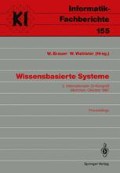Zusammenfassung
Grafik kann in wissensbasierten Systemen ebenso wie in anderen Programmen zur Visualierung von Ergebnissen der Verarbeitung eingesetzt werden. Die charakteristische, darüber hinausgehende Anforderung, die von der Künstlichen Intelligenz (KI) an die grafische Datenverarbeitung gestellt wird, ist die visuelle Darstellung der Wissensbasis. Hierbei geht es nicht um Gegenständliches wie im CAD-Bereich, auch nicht um quantitative Daten wie in der Präsentationsgrafik oder in der Geostatistik, sondern um die Darstellung von Strukturen der Wissensrepräsentation, z. B. in Form von semantischen Netzen. Eine weitere neue Anforderung an die grafische Datenverarbeitung ergibt sich aus der Einbindung von Grafikfunktionen in Sprachen der Künstliche Intelligenz, so z. B. in PROLOG (vgl. z. B. HÜB85).
Access this chapter
Tax calculation will be finalised at checkout
Purchases are for personal use only
Preview
Unable to display preview. Download preview PDF.
Literatur
Adorni, G.; Di Manzo, M.; Giunchiglia, F.: From Descriptions to Images: What Reasoning in Between? In: O Shea, T. (Hrsg.): Advances in Artificial Intelligcncc. Amsterdam, New York, Oxford (1985).
Allgayer, J.: Eine Graphikkomponente zur Integration von Zeigehandlungen in natürlichsprachliche Kl-Systeme. In: HOM86, S. 284–298.
Berhard, A.: ICONS and User-Interface Communication. In: Kunii, T. L. (Hrsg.): Computer Graphics. Visual Technology and Art. Berlin (1985), S. 215–227.
Böcker, H.-D.; Fischer, G.; Nieper, PL: The Enhancement of Understanding through Visual Representations. 1886 Conference on Human Factors in Computing Systems. Marriott Copley Place, Boston, April, 13–17, 1986. (im Druck)
Bowman, W. J.: Graphic Communication. New York, London, Sidney 1968.
Bullinger, Fl.-J. (Hrsg.): Software-Ergonomie 85. Mensch-Computer-Interaktion. Stuttgart(1985
Enderle, G.; Kansy, K.; PfafF, G.: Computer Graphics Programming. GKS — The Graphics Standard. Berlin Heidelberg New York (1984).
Ehrig. FF; Nagl, M.; Rozenberg, G. (Hrsg.): Graph-Grammars and Their Application to Computer Science. 2nd Intern. Workshop. Berlin: (1982).
Habel, C.: Prinzipien der Referentialität. Untersuchungen zur propositionalen Repräsentation von Wissen. Berlin (1985).
Hanne, K. H.; Fähnrich K. P.; Hoepelman, J. Ph.: Integrierte multimodale Mensch-Rechner- Kommunikation — ein Bericht eines kombiniert natürlichsprachlichen und graphischen Systems. In: BUL85, S. 66–74.
Hommel, G.; Schindler, S. (FIrsg.): Gl - 16. Jahrestagung I Informatik-Anwendungen — Trends und Perspektiven. Berlin, 6.- 10. Okt. 1986. Berlin Heidelberg New York (1986).
Hübner, W.; Markov, Z., I.: Eine Graphik-Erweiterung für PROLOG auf der Grundlage von GKS. In: Hansen, H. R. (Hrsg.): GI/OCG/ÖGI-Jahrestagung 1985. Berlin (1985).
Understanding graPHIGS. IBM Kingston, N. Y., Form SC33-8102 (1985)
Meier, A.: Methoden der grafischen und geometrischen Datenverarbeitung. Stuttgart: Teubner (1986).
Niemann, H.: Klassifikation von Mustern. Berlin: Springer (1983)
Quarendon, P.: WINSOM User s Guide. IBM UK Scientific Centre Winchester. Document UKSC 123 (1984).
Radig, B.: Bildverstehen und Künstliche Intelligenz, In: Laubsch, J. (Hrsg.): GWAI-84 8th German Workshop on Artificial Intelligence. Wingst/Stade, Oct. 8–12, 1984. Berlin: Springer (1985)
Rahmstorf, G.: Graphisch-interaktives Arbeiten mit Wissensstrukturen. In: IIOM86, S. 255–269.
Requicha, A. A. G.: Representations for Rigid Solids: Theory, Methods, and Systems. In: Computing Surveys 12, No. 4 (1984)
Ritchie, G. D.; Hanna, F. K.: Semantic Networks — A General Definition and a Survey. In: In-formation Technology: Research and Development 2, p. 187–231 (1983)
Ruttkay, Z.; Allen, R. H.; Laczik, B.: A multiparadigm user interface for CAD. In: First Euro-graphics Workshop on Intelligent CAD Systems. 21.–24. April 1987. Leeuwenhorst Congress Centre, Noordwijkerhout, Holland (Draft Proceedings).
Schefe, P.: Künstliche Intelligenz — Überblick und Grundlagen. Mannheim: BI Reihe Informatik/53 (1986).
Sowa, J. F.: Conceptual Structures. Information Representation in Mind and Machine. Reading: Addison-Wesley (1984).
Wisskirchen, P.: Graphische Kernsysteme und Programmiermethoden der Künstlichen Intelligenz: Systematische Ansätze und Wechselwirkungen In: IIOM86, S. 243–254.
Author information
Authors and Affiliations
Editor information
Editors and Affiliations
Rights and permissions
Copyright information
© 1987 Springer-Verlag Berlin Heidelberg
About this paper
Cite this paper
Rahmstorf, G. (1987). Grafische Funktionen in der Künstlichen Intelligenz. In: Brauer, W., Wahlster, W. (eds) Wissensbasierte Systeme. Informatik — Fachberichte, vol 155. Springer, Berlin, Heidelberg. https://doi.org/10.1007/978-3-642-88719-2_17
Download citation
DOI: https://doi.org/10.1007/978-3-642-88719-2_17
Publisher Name: Springer, Berlin, Heidelberg
Print ISBN: 978-3-540-18494-2
Online ISBN: 978-3-642-88719-2
eBook Packages: Springer Book Archive

